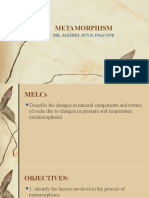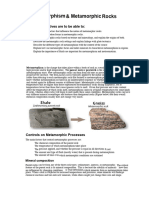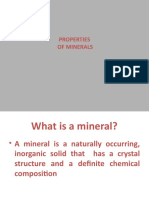Earth Science
Earth Science
Uploaded by
avaCopyright:
Available Formats
Earth Science
Earth Science
Uploaded by
avaOriginal Description:
Copyright
Available Formats
Share this document
Did you find this document useful?
Is this content inappropriate?
Copyright:
Available Formats
Earth Science
Earth Science
Uploaded by
avaCopyright:
Available Formats
TASK SHEET: ROCK FORMATION AND METAMORPHISM
A. Identify the following terms being described below.
1. The slow process where older minerals decompose and form minerals.
2. This process takes place when dissolved mineral grains from high pressure areas recrystallize in areas
with lower pressure.
3. This happens when minerals stretch instead of breaking when they are subjected to deformational
forces in high temperatures.
4. This process occurs when mineral grains change in size and shape from the original mineral.
5. This happens when there is a change in the mineral structure while retaining the same chemical
composition.
B. Write true if the statement is correct, and write false if it is otherwise.
1. A protolith is always an igneous rock.
2. Weathering changes the protolith into metamorphic rocks.
3. If a rock begins to melt under high temperature, it will form an igneous rock.
4. The change in the protolith refers to the change in the texture and mineralogy from the original rock.
5. Rocks on the surface of Earth that are exposed to the sun will always
undergo metamorphism.
6. A polymorph of pyrite (FeS2) is troilite (FeS).
7. When limestone changes to marble, calcite crystals found in limestone become larger crystals in the
process known as recrystallization.
8. The weathering of potassium-rich feldspar by rainwater resulting in the formation of muscovite
crystals in rocks is a form of neocrystallization.
9. Pressure solution occurs when pressure is applied to the protolith and it bends instead of breaking.
10. Plastic deformation occurs when the minerals in a rock dissolve in hot water and recrystallize
elsewhere when the rock is subjected to intense pressure.
C. Use the graph to answer the questions that follow:
1. What are the estimated minimum temperature and pressure values for phyllite to form?
2. Which rock in the graph is formed through high-grade metamorphism?
3. Which rock in the graph is formed nearest to the surface?
4. Which rock in the graph is formed under the highest pressure?
5. What is the metamorphic grade of slate?
TASK SHEET: ROCK FORMATION AND METAMORPHISM
D. Instruction: Answer the following questions.
1. Suppose that you have the technology to create metamorphic rocks from existing materials. What do
you think this technology will do to the minerals?
2. Suppose that you want to form quartz from shale. How will you develop your technology to be able to
do this?
3. You want to survey conditions that can form metamorphic rocks. What devices can you develop to do
this?
4. You observed that there was an alteration of rocks after a meteorite has struck. How would you
explain this?
5. Suppose that you want to develop technology to control the formation of metamorphic rocks. What
are the things that your technology must be able to control?
6. Suppose that igneous intrusions and the Earth’s geothermal temperature are unavailable, and you
want to use these factors to alter a rock. What other options related to these can you use?
You might also like
- Zeolites of The World Updated PDFDocument565 pagesZeolites of The World Updated PDFeric75% (4)
- DETAILED LESSON PLAN Earth and Life Sciences Grade 11 Week 8Document7 pagesDETAILED LESSON PLAN Earth and Life Sciences Grade 11 Week 8Austin Capal Dela Cruz100% (2)
- Evolution of Igneous Rocks Crustal Formation POGIL RevisedDocument5 pagesEvolution of Igneous Rocks Crustal Formation POGIL Revisedurbaitissciencelab3474100% (1)
- Metamorphic, Igneous and Sedimentary Rocks : Sorting Them Out - Geology for Kids | Children's Earth Sciences BooksFrom EverandMetamorphic, Igneous and Sedimentary Rocks : Sorting Them Out - Geology for Kids | Children's Earth Sciences BooksNo ratings yet
- G11 Earth ScienceDocument14 pagesG11 Earth ScienceAlthea RivadeloNo ratings yet
- Q1 Module 4 Endogenic ProcessesDocument11 pagesQ1 Module 4 Endogenic ProcessesAlea ZabaldicaNo ratings yet
- 3. EDITED METAMORPHISMDocument18 pages3. EDITED METAMORPHISMMark Ian RiezaNo ratings yet
- AITE - CORSCI 01 - MODULE 2Document5 pagesAITE - CORSCI 01 - MODULE 2Leonard BobadillaNo ratings yet
- Week 4Document4 pagesWeek 4janice alquizarNo ratings yet
- Rock Cycle WorksheetDocument4 pagesRock Cycle Worksheetyardservices2000No ratings yet
- ELS Q1 Module 4 MetamosphismDocument8 pagesELS Q1 Module 4 MetamosphismbutalgoldjenlyraeNo ratings yet
- Els W4Document4 pagesEls W4ASHLEY JADE NAIGANNo ratings yet
- Metamorphic Rocks WSDocument6 pagesMetamorphic Rocks WSbridget.duncanNo ratings yet
- Earth Science 4Document24 pagesEarth Science 4LNo ratings yet
- Earth Science: Quarter 2 - Module IvDocument24 pagesEarth Science: Quarter 2 - Module IvRainier Doctolero100% (1)
- Earth and Life Science Learning Competency 17Document44 pagesEarth and Life Science Learning Competency 17janine toledoNo ratings yet
- EESC 111 Worksheets Module 6Document5 pagesEESC 111 Worksheets Module 6Keira O'HowNo ratings yet
- Metamorphic RockDocument6 pagesMetamorphic Rockapi-245511282No ratings yet
- Earth and Life ScienceDocument4 pagesEarth and Life ScienceEJ RamosNo ratings yet
- LEARNING-ACTIVITY-FOR-METAMORPHISMDocument1 pageLEARNING-ACTIVITY-FOR-METAMORPHISMErrold LumiaresNo ratings yet
- AITE - CORSCI 01 - MODULE 3Document8 pagesAITE - CORSCI 01 - MODULE 3Leonard BobadillaNo ratings yet
- Earth Science Q2 Lesson 3Document3 pagesEarth Science Q2 Lesson 3legna.cool999No ratings yet
- 07 Metamorphic RocksDocument17 pages07 Metamorphic Rocksjcasafranca0% (1)
- Reviewer Questionnaire in Earth and Life ScienceDocument3 pagesReviewer Questionnaire in Earth and Life ScienceAndrew DizonNo ratings yet
- SHS-Earth-Science-for-STEM-M4-Q2-MetamorphismDocument23 pagesSHS-Earth-Science-for-STEM-M4-Q2-MetamorphismbobbielaguertaNo ratings yet
- The Rock Cycle Groupwork - Davina MegsonDocument5 pagesThe Rock Cycle Groupwork - Davina MegsondavvNo ratings yet
- Earth-Science w2 l2 q2 MetamorphismDocument35 pagesEarth-Science w2 l2 q2 MetamorphismCj Padata100% (1)
- Weekly Learning Activity Sheets Earth Science Grade 11 Quarter 2, Week 2BDocument8 pagesWeekly Learning Activity Sheets Earth Science Grade 11 Quarter 2, Week 2BShekaina Faith Cuizon LozadaNo ratings yet
- Earth Science Q2 Week 1Document10 pagesEarth Science Q2 Week 1John Errol Sayo - SampaguitaNo ratings yet
- AITE - CORSCI 01 - MODULE 4Document6 pagesAITE - CORSCI 01 - MODULE 4Leonard BobadillaNo ratings yet
- Metamorphism Group-ActivityDocument10 pagesMetamorphism Group-ActivityEmphres Lyan BaynosNo ratings yet
- Las 5Document6 pagesLas 5Jillian UmaliNo ratings yet
- Earth Science11 Q2 Module4 Teachermade Week4Document13 pagesEarth Science11 Q2 Module4 Teachermade Week4jlynclbznrvrNo ratings yet
- LP LP 1Document7 pagesLP LP 1gienald jane gargarNo ratings yet
- ES_Q2_Week2bDocument8 pagesES_Q2_Week2bClarizel CalimpongNo ratings yet
- Refer To The Diagram Below To Answer Item No. 3Document3 pagesRefer To The Diagram Below To Answer Item No. 3Leizel MundoNo ratings yet
- Earth and Life Science: Quarter 1 Module 1: Describe Where The Earth's Internal Energy Comes FromDocument9 pagesEarth and Life Science: Quarter 1 Module 1: Describe Where The Earth's Internal Energy Comes FromRICHARD CORTEZNo ratings yet
- Prepared By: Mrs. Amany Adel Gaber HussienDocument52 pagesPrepared By: Mrs. Amany Adel Gaber Hussienromaehab201912No ratings yet
- Metamorphic RocksDocument3 pagesMetamorphic RocksJames JosephNo ratings yet
- 3rd Summative Earth and Life ScienceDocument1 page3rd Summative Earth and Life ScienceDYlone FelongcoNo ratings yet
- Topic 8 (Metamorphosis)Document51 pagesTopic 8 (Metamorphosis)lester bernardinoNo ratings yet
- Exogenic and Endogenic ProcessDocument31 pagesExogenic and Endogenic ProcessMiles AmitNo ratings yet
- 11 Earth Science l4Document27 pages11 Earth Science l4hiiampeterparker2No ratings yet
- Earthscienceforstem q2 Mod4 Metamorphism v2Document26 pagesEarthscienceforstem q2 Mod4 Metamorphism v2Jhamilla AdajarNo ratings yet
- Endogenic Process Part 2 PDFDocument35 pagesEndogenic Process Part 2 PDFIvan ZenitramNo ratings yet
- Earth Science (SHS) - Q2 - Mod4 - Methamorphisim - v2Document27 pagesEarth Science (SHS) - Q2 - Mod4 - Methamorphisim - v2Emer Perez100% (8)
- PDF 1719734956915Document3 pagesPDF 1719734956915mbb719198No ratings yet
- Earths Source of Heat and Magmatism 1Document41 pagesEarths Source of Heat and Magmatism 1Eli ..No ratings yet
- Summary For All Update QuestionsDocument28 pagesSummary For All Update QuestionsYewba BukoNo ratings yet
- Earth Science SHS 12.2 What Is MetamorphismDocument15 pagesEarth Science SHS 12.2 What Is MetamorphismCamille AnibNo ratings yet
- Earth Science - Q2 ADMDocument217 pagesEarth Science - Q2 ADMeliNo ratings yet
- Earth and Life Science: Quarter 2 - Module 5 & 6: Exogenic Processes and The Earth'S Internal HeatDocument11 pagesEarth and Life Science: Quarter 2 - Module 5 & 6: Exogenic Processes and The Earth'S Internal HeatJonald LopezNo ratings yet
- ES - Section 4.4 pg.106-111 (Metamorphic Rock)Document7 pagesES - Section 4.4 pg.106-111 (Metamorphic Rock)Romnick MagdaraogNo ratings yet
- 02 Metamorphic Petrology - 1Document10 pages02 Metamorphic Petrology - 1Eadaw100% (1)
- Earth and Life Science Q1 - M8Document10 pagesEarth and Life Science Q1 - M8Migz Arlz14No ratings yet
- Metamorphism 2Document76 pagesMetamorphism 2driegran95100% (1)
- Task 4d The Rock CycleDocument2 pagesTask 4d The Rock CycleLeizl Anne PozonNo ratings yet
- Final Activity Sheet Week 1Document10 pagesFinal Activity Sheet Week 1Arlyn Pong Pling Pio100% (2)
- 8metamorphism and Its Effects in Rock Formation - Copy FOR PRINTINGDocument2 pages8metamorphism and Its Effects in Rock Formation - Copy FOR PRINTINGPaul MarcoNo ratings yet
- Minerals Rocks and Fossils Study Guide With AnswersDocument2 pagesMinerals Rocks and Fossils Study Guide With Answersapi-244714189100% (2)
- Clariant Chart Flotation of Frequently Occurring Minerals 2024 ENDocument1 pageClariant Chart Flotation of Frequently Occurring Minerals 2024 ENPablo SantibáñezNo ratings yet
- NI 43 101 Don Mario September 2013Document69 pagesNI 43 101 Don Mario September 2013Thalia QuispeNo ratings yet
- Introduction To MineralogyDocument16 pagesIntroduction To MineralogyEmily Faith BelcenaNo ratings yet
- Long Opposed Bar IIDocument1 pageLong Opposed Bar IIJakes SchmidtNo ratings yet
- Igneous Rock Clan Part 2Document22 pagesIgneous Rock Clan Part 2Rafli Riandi KusnadiNo ratings yet
- Defects in Crystals-Che222Document18 pagesDefects in Crystals-Che222mgfmhcvjhj;No ratings yet
- Solid State Theory PDFDocument28 pagesSolid State Theory PDFGOURISH AGRAWALNo ratings yet
- Rock & Gem Magazine - August 2014Document68 pagesRock & Gem Magazine - August 2014Soraya Pastor67% (3)
- Steel SlagDocument13 pagesSteel SlagHemanth Peddavenkatappa GariNo ratings yet
- Atlas of Rock-Forming Minerals in Thin SectionDocument100 pagesAtlas of Rock-Forming Minerals in Thin Sectionniccilo100% (8)
- Limbaga - Problem Set 3Document5 pagesLimbaga - Problem Set 3EDISON LIMBAGANo ratings yet
- Crystallographic+planes+and+directions PDFDocument38 pagesCrystallographic+planes+and+directions PDFJoshuaNo ratings yet
- 2024-2 물리전자 Homework #1 풀이Document9 pages2024-2 물리전자 Homework #1 풀이ssojeong04No ratings yet
- Chapter 7 MSE 104 2024Document48 pagesChapter 7 MSE 104 2024Evan ChangNo ratings yet
- Minerals - MDocument50 pagesMinerals - MOdod DepoNo ratings yet
- Electron Backscattered Diffraction: Further ReadingDocument16 pagesElectron Backscattered Diffraction: Further Readingyourself_bigfoot_comNo ratings yet
- Gambar Mineral Gambar KristalografiDocument8 pagesGambar Mineral Gambar KristalografiSamuel TangkaNo ratings yet
- Cacat KristalDocument12 pagesCacat KristalBudi IstanaNo ratings yet
- Solid-State Previous-Years Hots Value-Based QuestionsDocument1 pageSolid-State Previous-Years Hots Value-Based Questionsilias19730% (1)
- ALS Metallurgy - Iron Ore Process DevelopmentDocument8 pagesALS Metallurgy - Iron Ore Process DevelopmentDeepakKumarGorai100% (1)
- What Is Atomic Packing Factor (And How To Calculate It For SC, BCC, FCC, and HCP) - Materials Science & EngineeringDocument1 pageWhat Is Atomic Packing Factor (And How To Calculate It For SC, BCC, FCC, and HCP) - Materials Science & EngineeringHIMANSHU SOMKUWARNo ratings yet
- Fluorescent Minerals TabDocument2 pagesFluorescent Minerals TabBGseekerNo ratings yet
- Assignment No 4Document15 pagesAssignment No 4Samama FahimNo ratings yet
- Crystallographic Directions and Planes - Miller IndexDocument6 pagesCrystallographic Directions and Planes - Miller IndexPradeep ChaudhariNo ratings yet
- Crystal Structure and Correlated Properties DGSGDGDocument23 pagesCrystal Structure and Correlated Properties DGSGDGChinar MathurNo ratings yet
- Gemstone PropertiesDocument1 pageGemstone Propertiesmuhammad hamzaNo ratings yet
- Solid State Chemistry IITDocument22 pagesSolid State Chemistry IITAdiChemAdi100% (23)
- Properties of MineralsDocument41 pagesProperties of MineralsBeverly DatuNo ratings yet
- Geology Practical 1Document20 pagesGeology Practical 1Huzefa Ali100% (1)

























































































